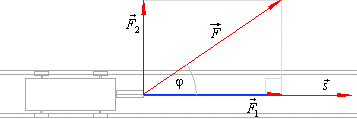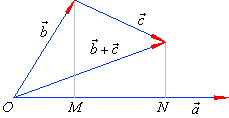|
|
Vectors in a Plane and Space |
|
 Vectors in
three-dimensional space in terms of Cartesian coordinates
Vectors in
three-dimensional space in terms of Cartesian coordinates |
 Scalar product or dot
product or inner product
Scalar product or dot
product or inner product |
 Orthogonality or
perpendicularity of two vectors
Orthogonality or
perpendicularity of two vectors |
|
Different positions of two vectors and the corresponding values of
the scalar product |
 Square of magnitude of
a vector
Square of magnitude of
a vector |
 Scalar product of unit
vectors
Scalar product of unit
vectors |
 Scalar or dot product
properties
Scalar or dot product
properties |
|
|
|
|
|
|
| Scalar product or dot
product or inner product |
| On the beginning of this
section we have already mentioned that there are physical quantities as; force,
velocity, acceleration, electric and magnetic field and so on, which all have vectors’ properties. |
There’s another group of physical quantities as; distance, time, speed, energy, work, mass and so on, which
have magnitude but no direction, called scalar quantities or scalars. |
| The word scalar derives from the English
word "scale" for a system of ordered marks at fixed intervals used in measurement, which in turn is derived
from Latin scalae - stairs. |
| The magnitude of any vector is a scalar. |
| The
scalar (numeric) product of two vectors geometrically is the product of the length of the first vector
with projection of the second vector onto the first, and vice versa, that is |
|
|
 |
 |
|
| The scalar or the dot product of two vectors returns as the result scalar quantity as all three factors on the
right side of the formula are scalars (real numbers). |
| The result will be positive or negative depending on
whether is the angle j between the two vectors are acute or obtuse. |
| For example, in physics mechanical work
W is the dot product of force
F and displacement
s, |
|
|
| Obviously, a change of the angle between the two vectors
changes the value of the work W, from the maximal value |
| for
j
= 0°
=>
W
= | F | ·
|
s |,
|
| to the minimal value |
| for
j
= 180°
=>
W
= - |
F | ·
|
s |. |
|
 |
|
| For j
= 90° the force
F
does any work on an object, since
|
 |
|
| It is only the component of
the force along the direction of motion of the object which does any
work. |
|
| Orthogonality or
perpendicularity of two vectors |
| Therefore, if the scalar product of two vectors,
a
and b
is zero, i.e., a ·
b
= 0 then the two vectors are orthogonal. |
| And inversely, if two vectors are perpendicular, their scalar product is zero. |
|
|
|
| Different positions of two vectors and the corresponding values of
the scalar product |
| Different positions of two vectors and the corresponding values of their scalar product are shown in
the below figures. |
|
|
 |
|
|
|
 |
|
| Square of magnitude of
a vector |
| The scalar product of a vector with itself,
a ·
a
= a2
is the square of magnitude of a vector, that is |
|
|
| thus, |
 |
-
in the coordinate plane, |
and |
 |
-
in 3D space. |
|
|
| Scalar product of unit
vectors |
| The unit vectors,
i,
j and k,
along the Cartesian coordinate axes are orthogonal and their scalar products are, |
|
|
|
| Scalar or dot product
properties |
| a)
k
· (a · b)
= (k · a) · b
= a · (k · b),
k
Î
R |
| b)
a
· b = b · a |
| c)
a
· (b + c)
= a · b + a
· c |
| d)
a
· a = a2
= | a |2 |
|
 |
|
| According to the definition of the dot product, from the
above diagram, |
 |
then |
|
|
 |
what confirms the distribution law. |
|
|
|
|
The associative law does not hold for the dot product of more vectors, for example |
|
a
· (b · c) is
not equal
(a
· b) · c |
| since
a
· (b · c) is the vector
a
multiplied by the scalar b
· c,
while (a
· b) · c
is the vector c
multiplied by the scalar a
· b. |
|
|
|
|
|
|
|
|
|
|
| College
algebra contents
F |
|
 |
|
| Copyright
© 2004 - 2020, Nabla Ltd. All rights reserved. |